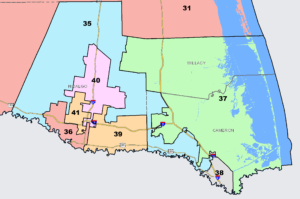The Mexican American Legislative Caucus in the Texas House has opened a second front in the legal war over the state’s new political maps.
The caucus on Wednesday turned to the state courts to challenge the constitutionality of the new state House map, arguing it violates state requirements for breaking county lines in drawing up the chamber’s 150 districts. The move comes on the heels of two lawsuits filed against the newly approved maps in federal court. The caucus on Wednesday simultaneously filed another federal lawsuit alleging the state’s new maps were drawn with discriminatory intent and violate the federal Voting Rights Act.
Texas redistricting fights have typically played out in federal courts, which decade after decade have found that lawmakers, often intentionally, flouted federal protections for voters of color in redistricting. Filed in Austin, MALC framed its federal lawsuit as an effort to “redress once again Texas’s sordid pattern of racial discrimination.”
However, the lawsuit filed in state district court in Travis County is tied to language in the state Constitution, which states that legislators drawing 150 districts for the Texas House are supposed to keep whole counties that have sufficient population to make up one House district.
MALC’s challenge centers on the reconfiguration of Cameron County in the Rio Grande Valley, which breaks the county line twice to create three different districts — only one of which is wholly contained within the county. The state’s “county line rule,” MALC argues, would require two districts to be drawn within Cameron with the remaining population connected to a single neighboring district, as was the case under the map the state used for the last decade.
The new lines in Cameron, drawn over the objections of lawmakers who represent the affected areas, would afford Republicans a newly competitive state House seat in an area currently dominated by Democrats. In its federal lawsuit, MALC alleges the lines would also “severely dilute” the ability of Latinos and the Spanish-speaking community in the area to elect their preferred candidates.
The swap and the objections to it are noted in this post. This is the first state court lawsuit against the redistricting effort, though the Gutierrez/Eckhardt suit will find its way there as well. The claim seems pretty straightforward. According to the population report for the State House map, HD37 has 164K voters in Cameron County and 20K in Willacy, while HD35 has 70K in Cameron and 123K in Hidalgo. All 186K voters in HD35 are in Cameron. The suit claims that according to the county rule in the state constitution, HD37 should be entirely within Cameron County, and those Willacy County voters would need to be swapped out, presumably to HD35 where about 20K of its voters would have to be in HD37. Here’s a quote from the lawsuit:
A key principle in both the plain language of the Texas Constitution itself and the Texas Supreme Court’s interpretation of the county line rule in light of Reynolds, is that for any county which has enough population for one or more representatives and also has a left-over surplus that cannot be wholly contained in the county, that surplus may only be joined in one single representative district with area from another contiguous county or counties.
Emphasis mine. I will note that HDs 35 (57-42 for Biden in 2020 and 38 (62-37 Biden) are reasonably Dem-friendly, while HD37 (51-48 Biden) is less so. Now, Willacy County was roughly 56-44 for Biden, so how Dem-friendly the HD35 portion of Cameron County is makes a difference here. I have to assume it’s better for Dems than the Willacy portion is, because otherwise the Republicans wouldn’t have bothered. Maybe they could still squeeze HD37 in a favorable way for themselves if it had to be entirely within Cameron, but in the end they didn’t. So this could be a difference maker, if the plaintiffs win.
On the federal side:
In its federal lawsuit, MALC challenges the new maps for Congress, the Texas House and the State Board of Education, saying they are intentionally discriminatory and mired in illegal racial gerrymanders. The caucus also raises specific claims on a litany of districts where they allege the Legislature packed and cracked communities of color to limit their electoral impact.
“The plans adopted by the State not only failed to increase Latino and minority opportunities for representation, they actually decreased them while increasing the number of districts in which Anglos form a majority of the eligible voter population,” the MALC complaint reads. “This turns the concept of representative democracy on its head.”
Echoing the two federal lawsuits already in the pipeline, MALC is also challenging the Legislature’s refusal to create additional districts in which Hispanic voters would control elections. Republicans, who had complete control over the redistricting process this year, declined to create those districts even as they reconfigured the congressional map to include the two additional U.S. House seats the state gained, the most of any state in this year’s reapportionment, because of its explosive growth.
See here and here for the other federal lawsuits. I don’t know what new MALC is bringing to the table, and as discussed I don’t have much faith in the federal courts on this matter, but I welcome all comers. The Statesman has more.


Well, this makes me change my mind. I originally thought SD-10 would most likely require fixing by the courts, since that’s what happened 10 years ago. However, I now think this is even more likely to get fixed since it’s such a straight forward violation of the county rule.
Pingback: Precinct analysis: The new State House map – Off the Kuff